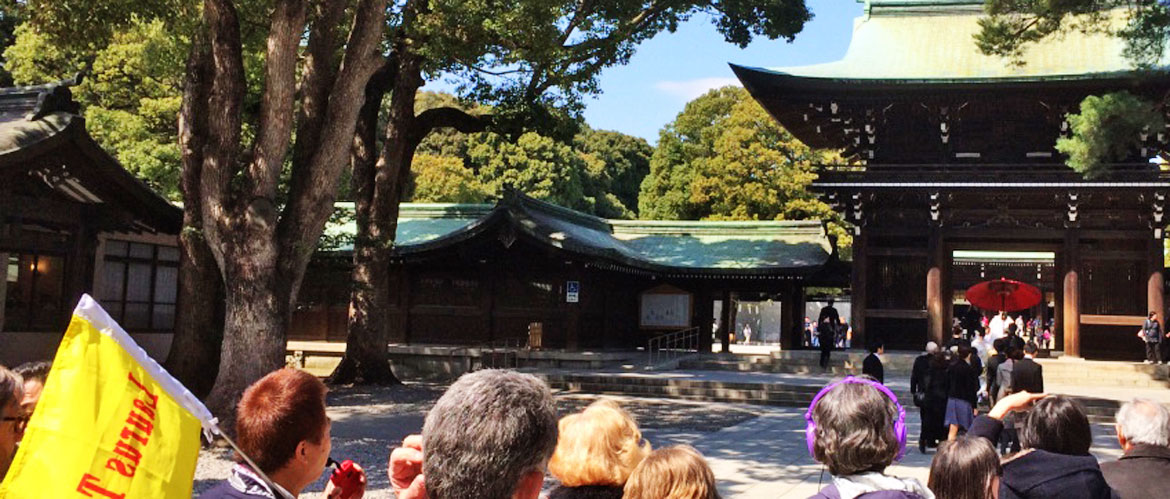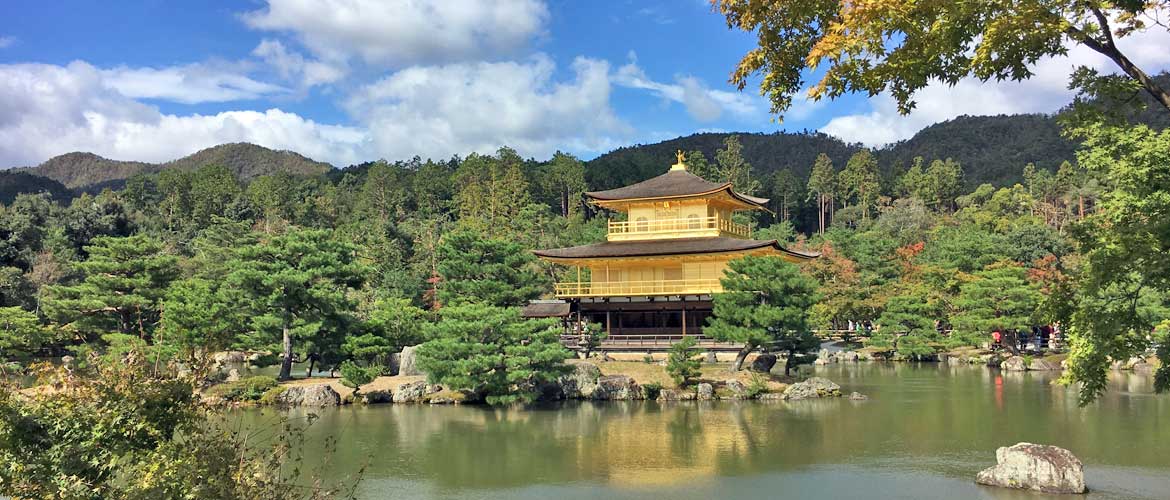
Tokyo – Kyoto – Osaka
This is a self-guided Japan tour with guided sightseeing for one day in Tokyo and half a day in Kyoto included. The tour is offered by request with no group departures scheduled. The price will be based on the number of travellers in your party, travel dates and class of hotels in use.
Day 1: Departing Home City
The journey begins with your transpacific flight departing from a city of your choice. You’ll lose a day upon crossing the International Date Line. International airfare is not included.
Day 2: Arrival in Tokyo
Welcome to Tokyo!
Transfer to the hotel on your on own by airport limousine shuttle bus or taxi.
Day 3: Tokyo (B)
Tokyo, literally meaning “eastern capital” and officially named Tokyo Metropolis, is one of the most populous mega-cities in the world with a population of 14 million (April 2022) in the city proper. Formerly known as Edo, the city has been the de facto seat of the Japanese government since 1603 when shogun Tokugawa Ieyasu chose the city for his headquarters. The shogun (general) was a hereditary commander ceremoniously appointed by the emperor but held real power over the country during the shogunate period between 1192 and 1867. Edo was renamed Tokyo after Emperor Meiji moved his seat from Kyoto in 1868 when the last shogun was forced to return power to the imperial court. The city covers an area of 2,187 square kilometres following the merger in 1943 of the city of Tokyo and Tokyo Prefecture.
The guide will meet you at the hotel at 9:00 AM and drop you off there before 5:00 PM . You’ll move around by taxi. The guided sightseeing today takes in the following:
- Meiji Jingu, a Shinto shrine dedicated to Emperor Meiji (1852 -1912) and his wife
- Observation hall atop Tokyo Metropolitan Government Building
- The plaza and East Gardens outside the Imperial Palace (the palace itself is closed to tourists)
- Senso-ji, the oldest Buddhist temple in Tokyo
Day 4: Tokyo (B)
Free day to explore on your own. There are lots of interesting places to visit in Tokyo in addition to what you’ve visited on Day 3. Hama-rikyu gardens and the National Museum next to Ueno Park are perfect examples.
If you plan to go on a day trip to Kamakura or Nikko or Mt. Fuji combined with Hakone, please leave the hotel as early as possible. There are daily bus tours to Mt. Fuji and Hakone departing from Tokyo Station.
Day 5: Tokyo (B)
Free day to explore on your own.
Day 6: Tokyo – Kyoto (B)
This morning you’ll get to the train station on your own to board the shinkansen bullet train for Kyoto. You are advised to stop by the train station the day before to get familiar with its layout to avoid being overwhelmed the next day. The rail journey takes about 2 hours.
The guide will meet you in the hotel lobby at noon to take you out on a half-day tour that includes Nijo Castle and Kiyomizu Temple. Nijo Castle is the place that witnessed the commencement and ending of the Tokugawa shogunate (1600 -1868). Kiyomizu Temple sits high above the city and provides stunning views of Kyoto. Three taxi rides are included (hotel => Nijo Castle => Kiyomizu-dera => hotel). Please note that taxis are unable to reach the front gate of Kiyomizu-dera. You are expected to walk 700 to 800 metres between the front gate and the drop-off/pick-up point.
Day 7: Kyoto (B)
Today is a free day for you to explore on your own. We recommend the Golden Pavilion Temple (Kinkaku-ji), Kyoto Imperial Palace and the famous Arashiyama Scenic Area (Bamboo Forest, Tenryo-ji etc). To get to Kinkaku-ji and Arashiyama, you are advised to take taxi because public buses to those places are always crowded.
Kinkaku-ji is a Zen Buddhist temple and one of the 17 locations comprising the Historic Monuments of Ancient Kyoto World Heritage Site.
Arashiyama (Storm Mountain) on the west side of Kyoto is a nationally-designated Historic Site and Place of Scenic Beauty. Key attractions here include the Togetsukyo Bridge, Tenryu-ji Temple and the Bamboo Grove.
Day 8: Kyoto (B)
Free day to explore on your own.
Our recommendations for today include Kyoto National Museum, Fushimi Inari Shrine (for hiking), the photogenic Kano River flowing through the city (perfect for a leisurely walk) and the Gion entertainment district (famous for geisha houses).
If you are not yet tired of temples, tranquil Ginkaku-ji or Silver Pavilion Temple is worth consideration. Even the most discriminating garden aficionados would find its landscape design and vegetation fascinating. Here, unlike Saiho-ji favoured by the late Steve Jobs, you don’t need to make a reservation and the exquisite moss gardens don’t cost extra!
Day 9: Kyoto – Osaka (B)
You’ll travel to Osaka on your own this morning. The rail journey to Osaka by bullet train takes less than 20 minutes. We recommend Osaka Castle and Dotonbori commercial district for your afternoon sightseeing.
Situated at the mouth of the Yodo River on Osaka Bay, Osaka is Japan’s third largest city by population after Tokyo and Yokohama and serves as a major economic hub. Osaka was once known as the “nation’s kitchen” because of its role as Japan’s rice trading centre during the Edo period. The main tourist attractions are Osaka Castle and Dotonbori commercial district in the heart of Osaka.
Day 10: Osaka (B)
Free day to explore on your own.
A day trip to Nara by commuter train is an option. The rail journey between Osaka Station and Nara Station takes about 50 minutes each way with many departures to choose from. Nara’s magnificent Todai-ji alone is worth the journey.
You may also want to consider a day trip to Hiroshima and nearby Miyajima by a combination of shinkansen bullet train, local commuter train and taxi. You can buy train tickets at the station on the day of travel. If reserved seats are sold out, you may opt for tickets with non-reserved seats and go straight to cars designated for passengers holding such tickets. The day trip requires 10 hours with 3 hours on the train (1 ½ hours each way by the fastest train called Nozomi). If you only visit Hiroshima and focus on the Peace Memorial Park (museum, outdoor monuments etc) there, you can finish the excursion in 8 hours.
ABOUT HIROSHIMA:
Hiroshima, literally meaning ‘broad island’, is the capital of Hiroshima Prefecture and the largest city in the Chugoku region with a population of 1.2 million. Hiroshima is best known as the first city in history to be targeted by a nuclear weapon when the United States Army Air Forces dropped an atomic bomb on the city (and later on Nagasaki) at 8:15 a.m. on August 6, 1945, near the end of World War II. The highlight in Hiroshima, understandably but sadly, is the Peace Memorial Park which includes the Peace Memorial Museum, and the Atomic Bomb Dome that once served as the industrial promotion hall of the local prefect.
ABOUT MIYAJIMA
Officially known as Itsukushima, Miyajima is a small island (30 square kilometres, population 1,760) in Hiroshima Bay famous for its forests and ancient temples. The main attraction here is the giant orange-coloured floating torii gate which marks the entrance to the Itsukushima Shrine.
Day 11: Osaka – Return Home (B)
Transfer to Kansai International Airport by airport express train or airport shuttle bus on your own. Please feel free to ask hotel concierge for assistance with ticket purchase.
If it is much cheaper for you to fly back from Tokyo, we will adjust the itinerary and price quote to suit you.

Hotel List
| City | Nights | Hotel | Category |
| Tokyo | 4 | Royal Park Hotel Shiodome or similar | first class/4 stars |
| Kyoto | 3 | Kyoto Century Hotel or similar | first class/4 stars |
| Osaka | 2 | Hotel Hankyu Respire Osaka or similar | first class/4 stars |
Contact us for a competitive price quote.
We require a non-refundable fee of $50 to provide you with a price quote. The fee should be paid by e-transfer or a credit card (Visa or Mastercard).
|
Tour price will include:
|
Tour price will not NOT include:
|
Passport & Visa
Your passport should have at least one blank visa page and six months validity at the end of the tour.
For stays of 90 days or less, visa is not required if you are a Canadian or US citizen. Contact us for other nationalities.
Immunization
Proof of vaccination including booster shots against COVID-19 may be required.
No other inoculation is required to the best of our knowledge. We recommend vaccination against hepatitis A and suggest that you check out the websites of Health Canada and the U.S. CDC for more information.
Japan Travel Health Tips
Japan is among the cleanest countries in the world and boasts a national average life expectancy that is rivalled by few. In Japan, tap water is potable. Always keep a roll of toilet paper and a bottle of hand sanitizer handy when you travel. This advice applies to any destination.
Local Currency & Credit Card
Japan: yen (JPY)
Withdrawing cash from local ATMs after arrival remains our recommended method of currency exchange. For transactions over $50 you may want to use a credit card. Keep your inventory of local currency low as you approach the end of your trip. You may tip the Japanese guide in any major hard currency including Canadian dollars.

